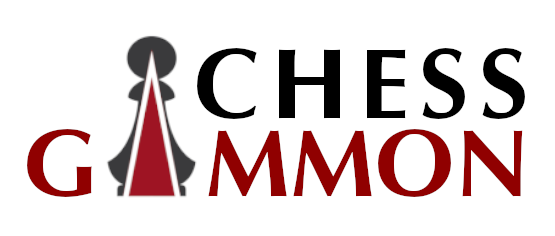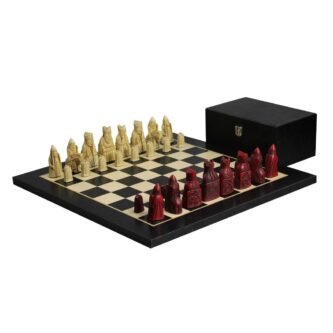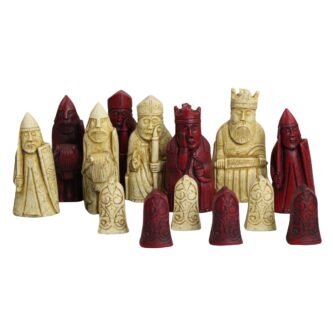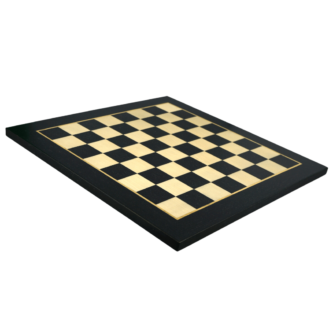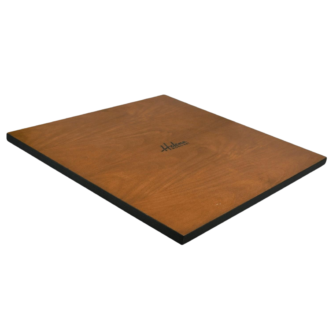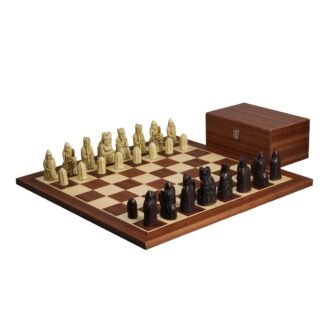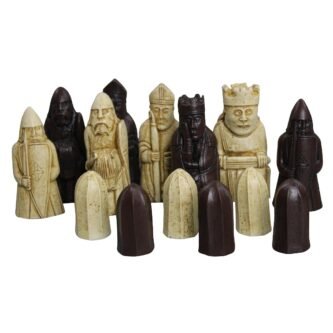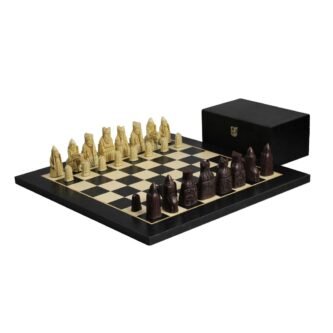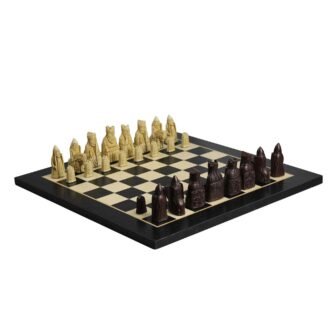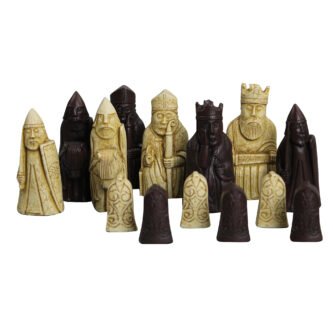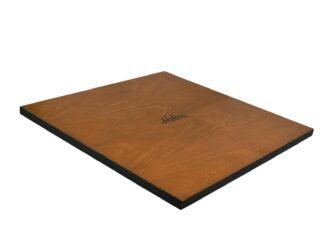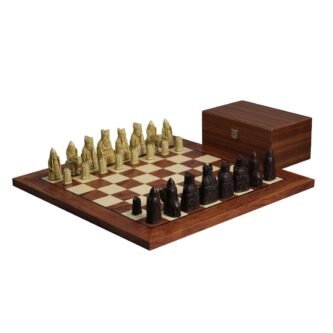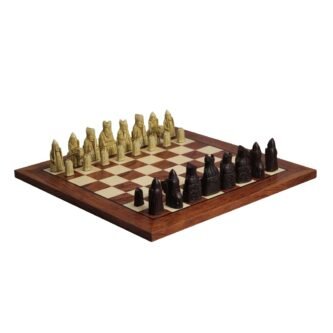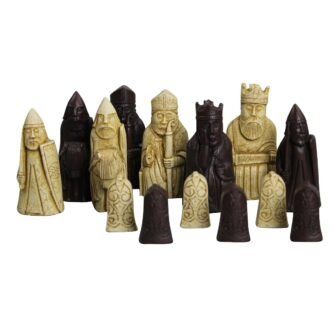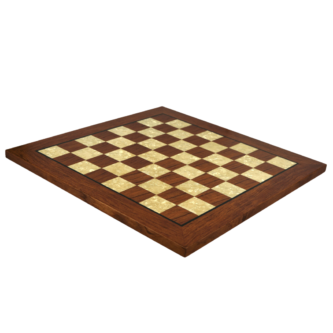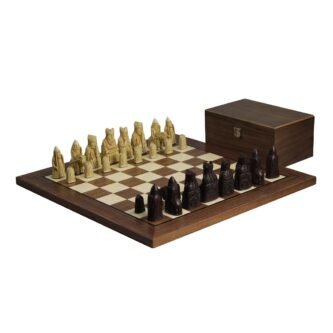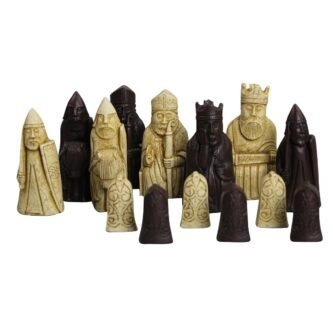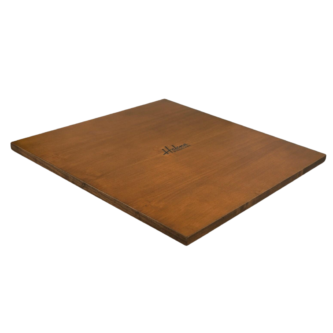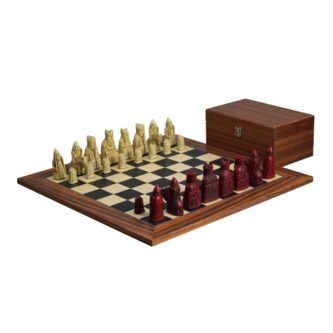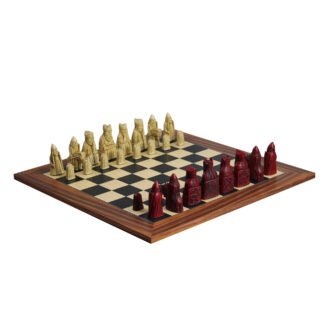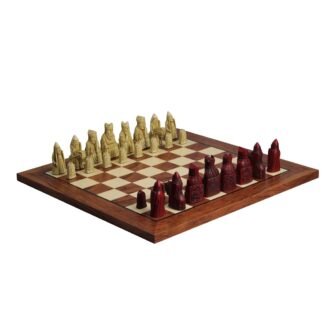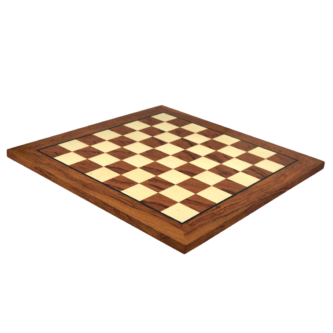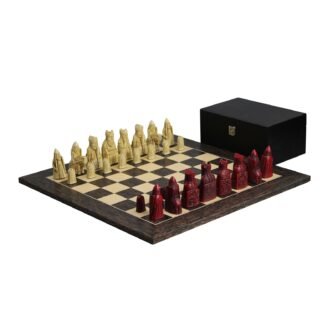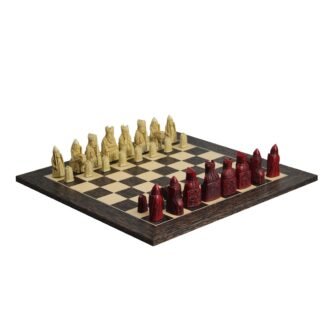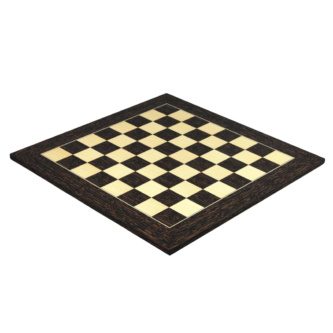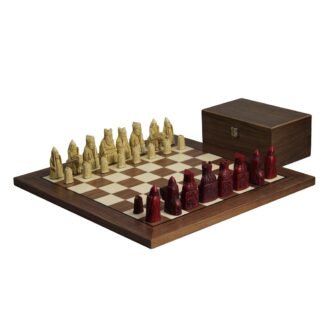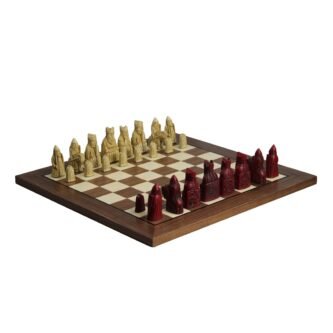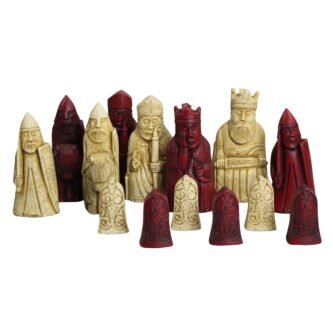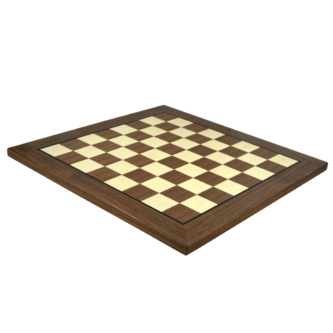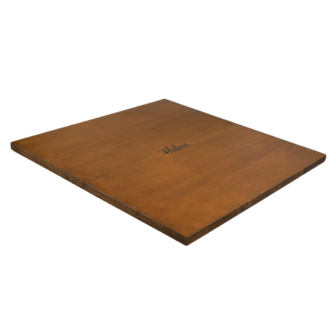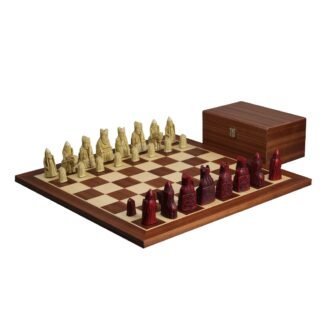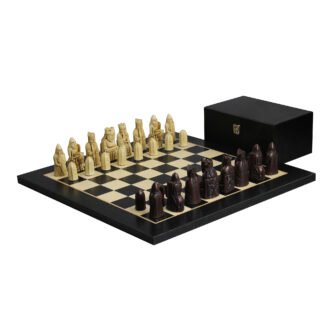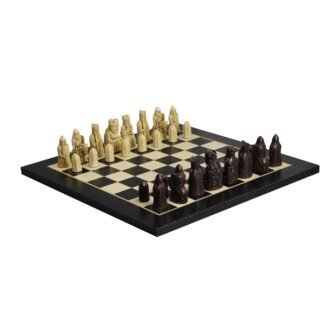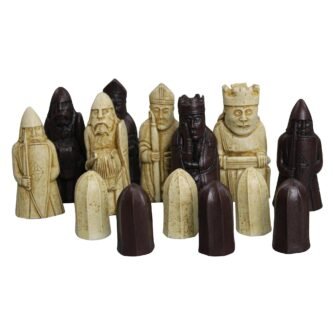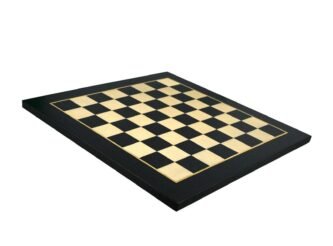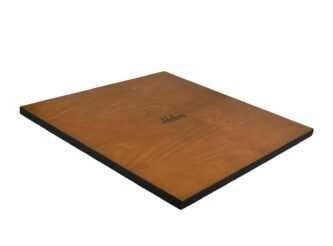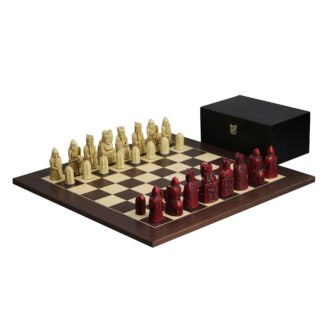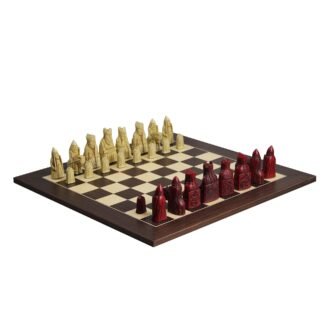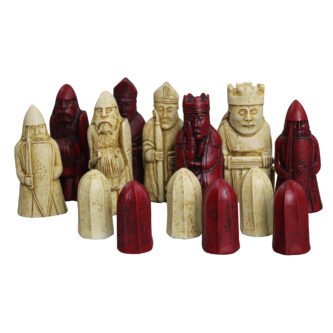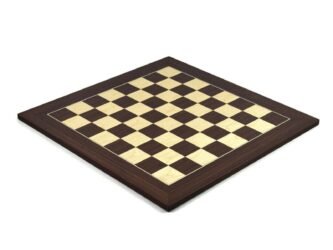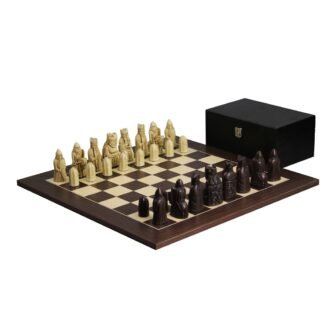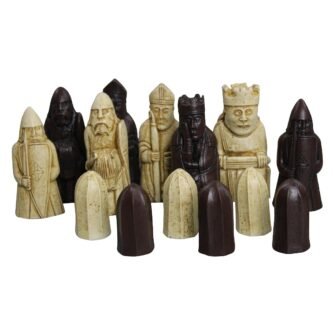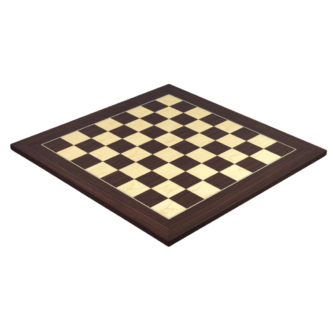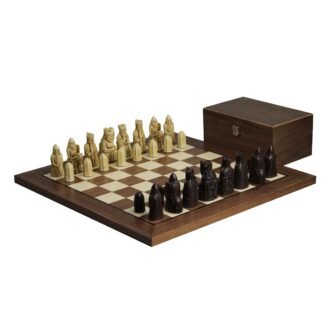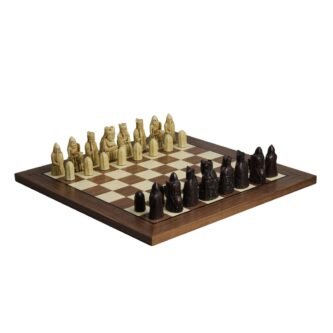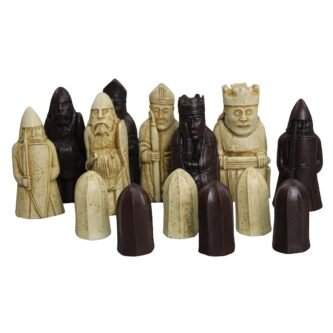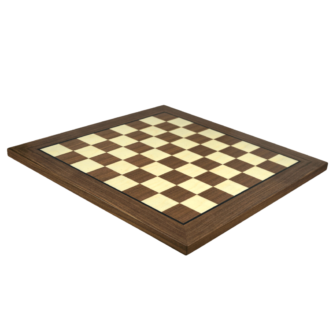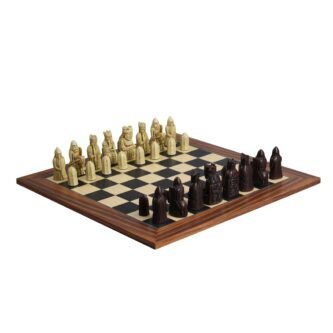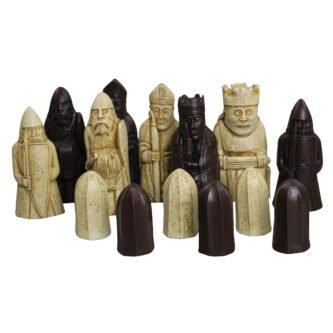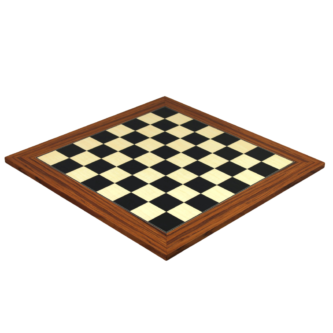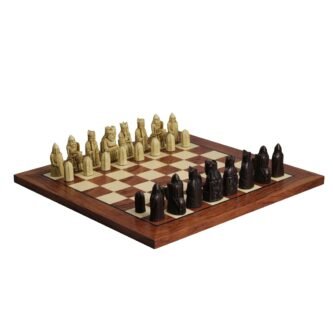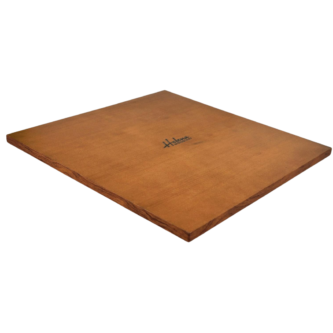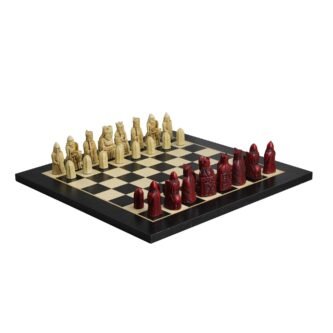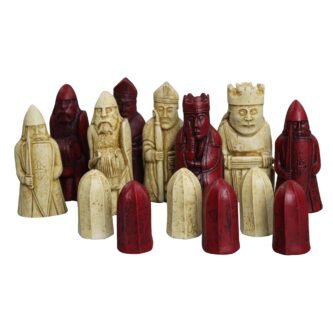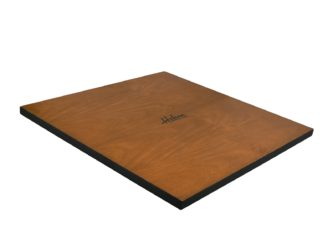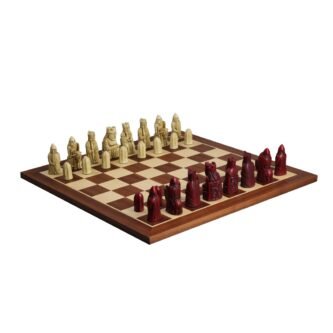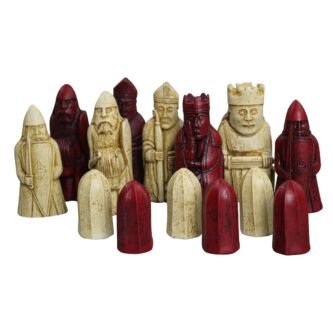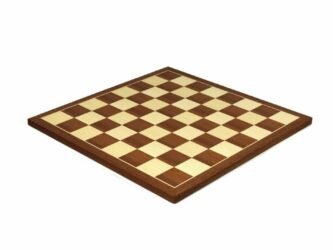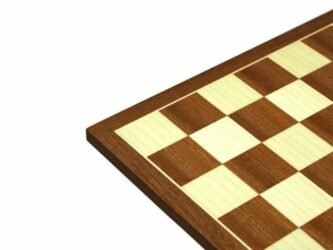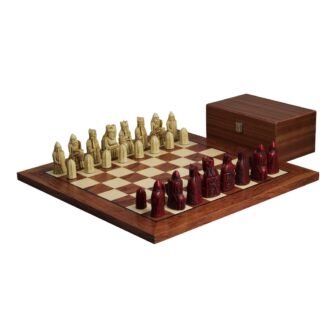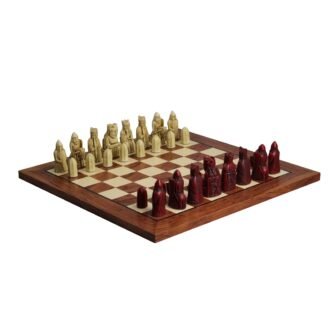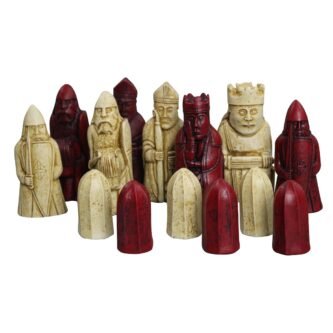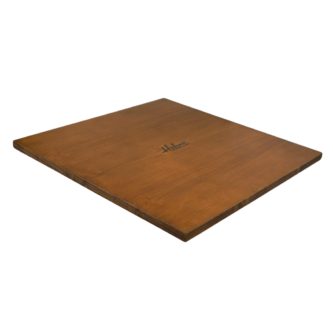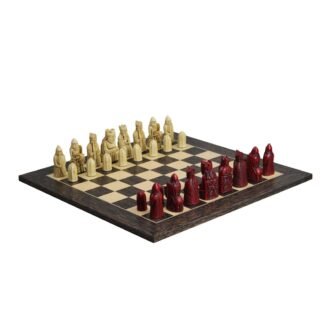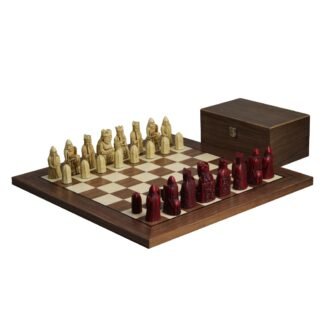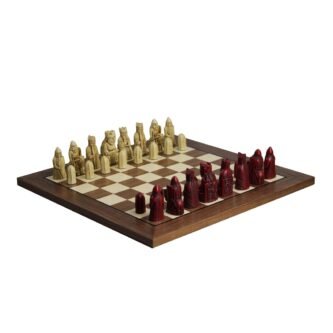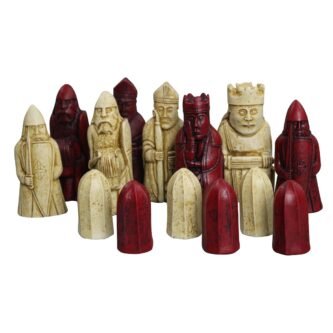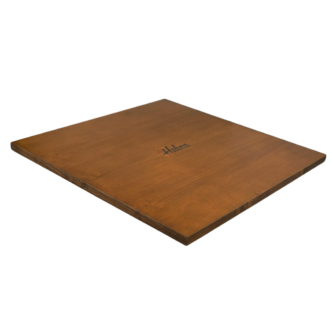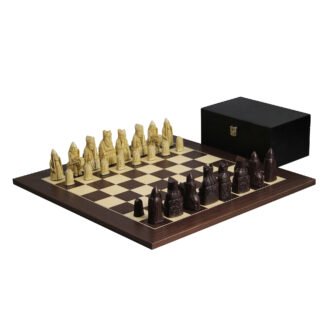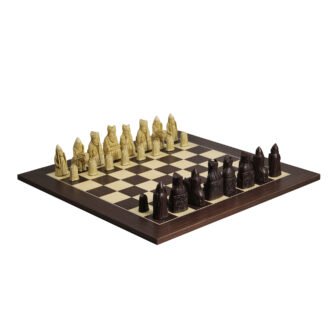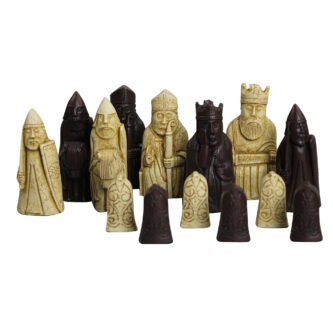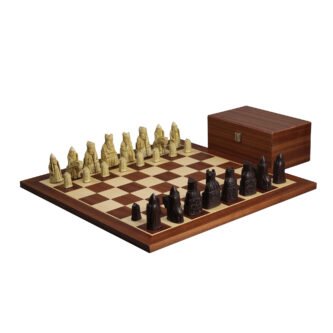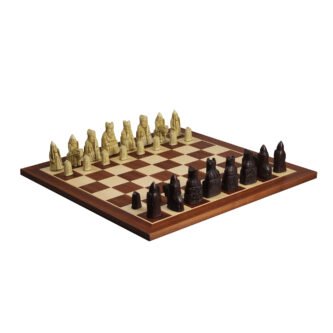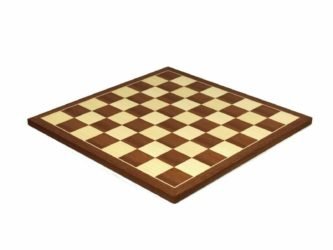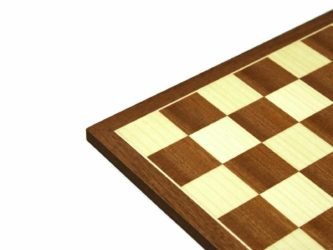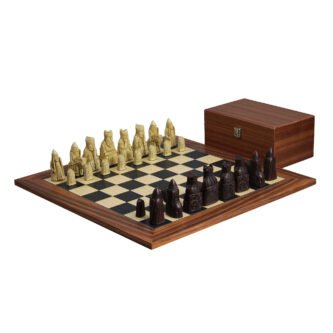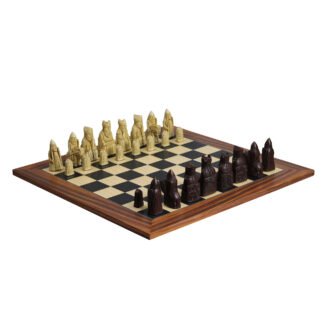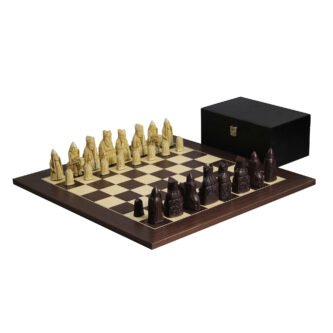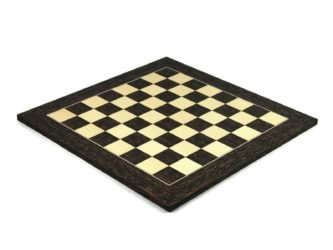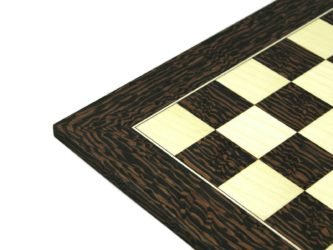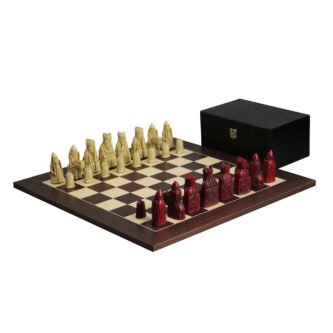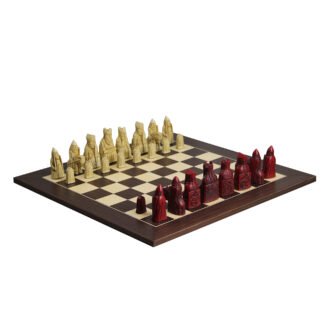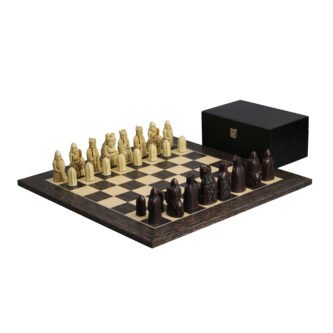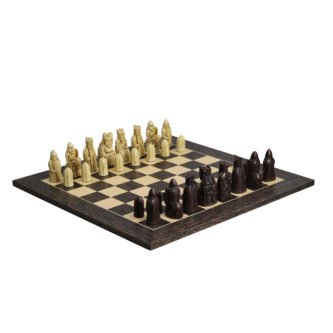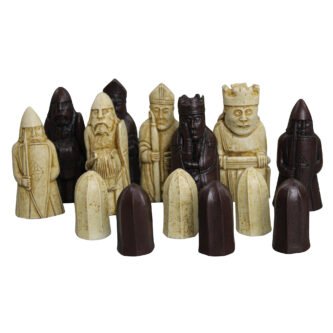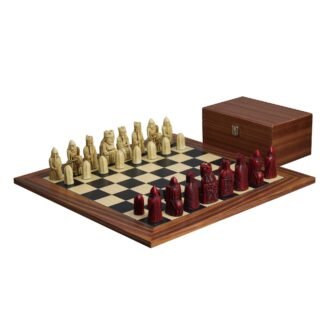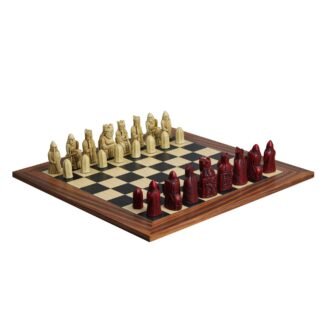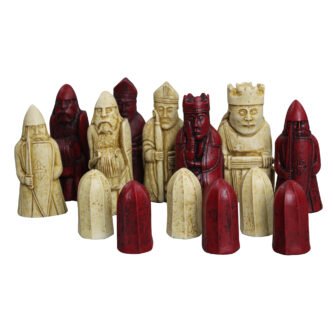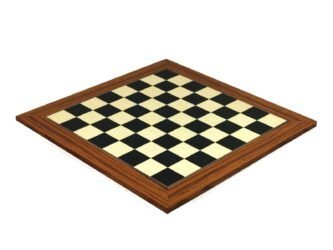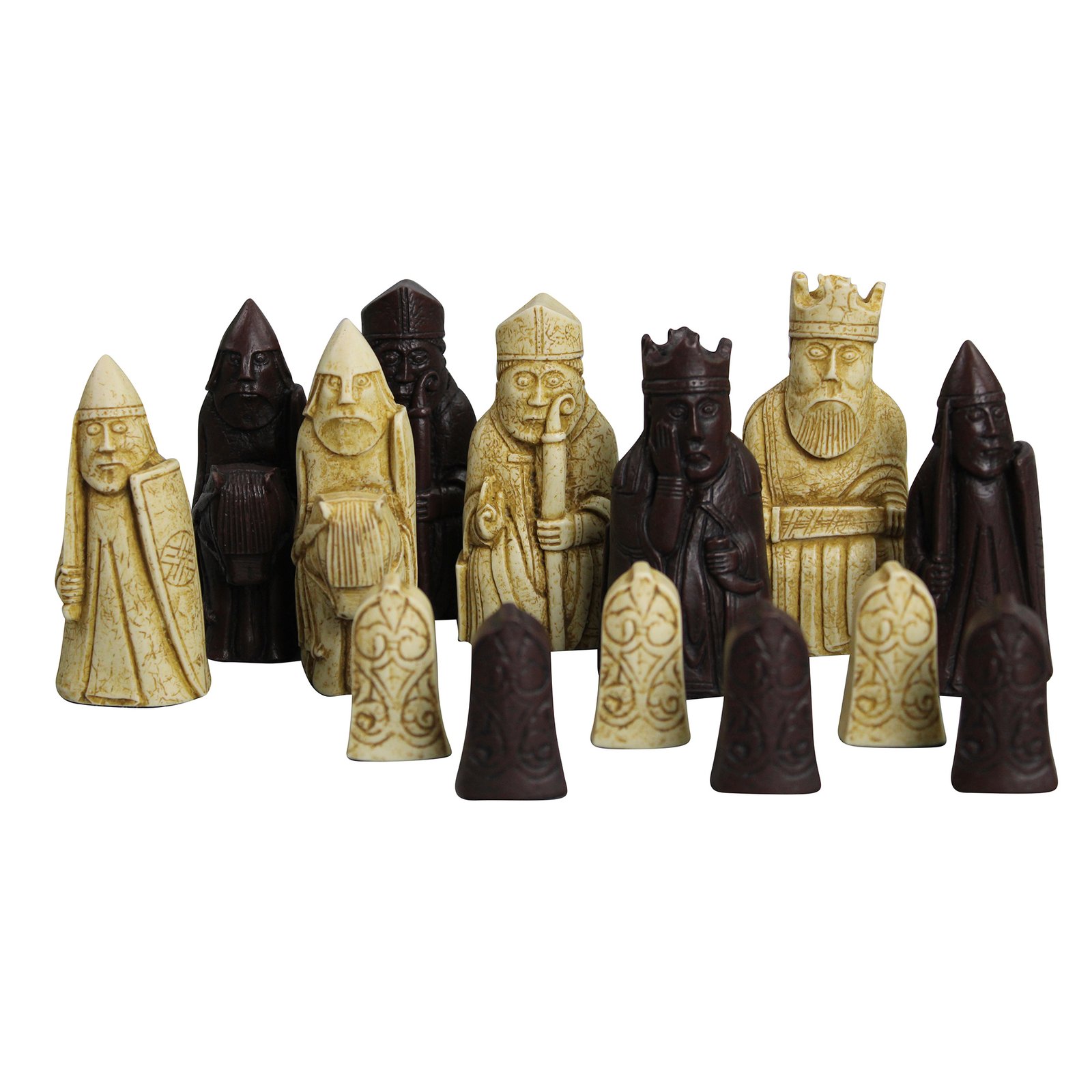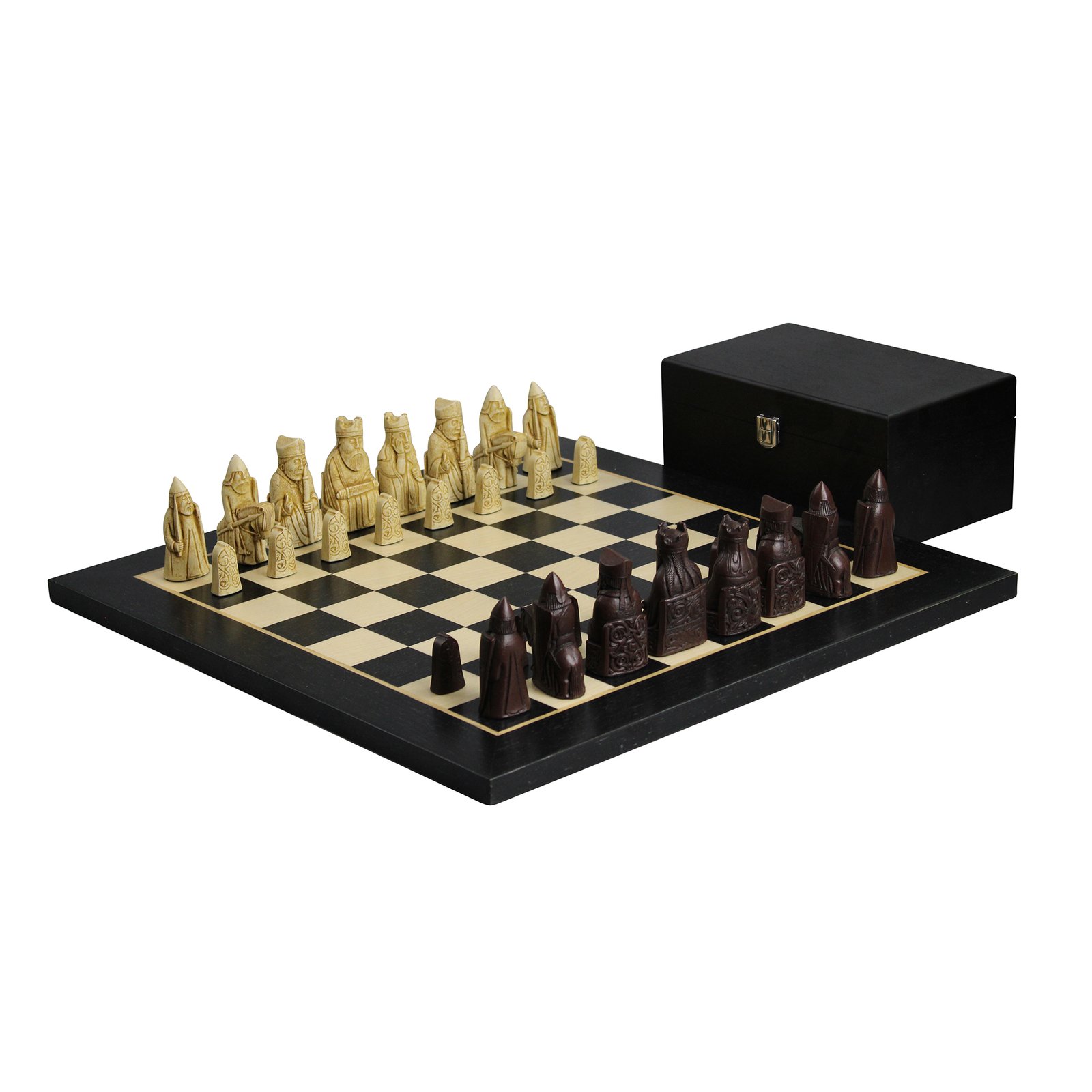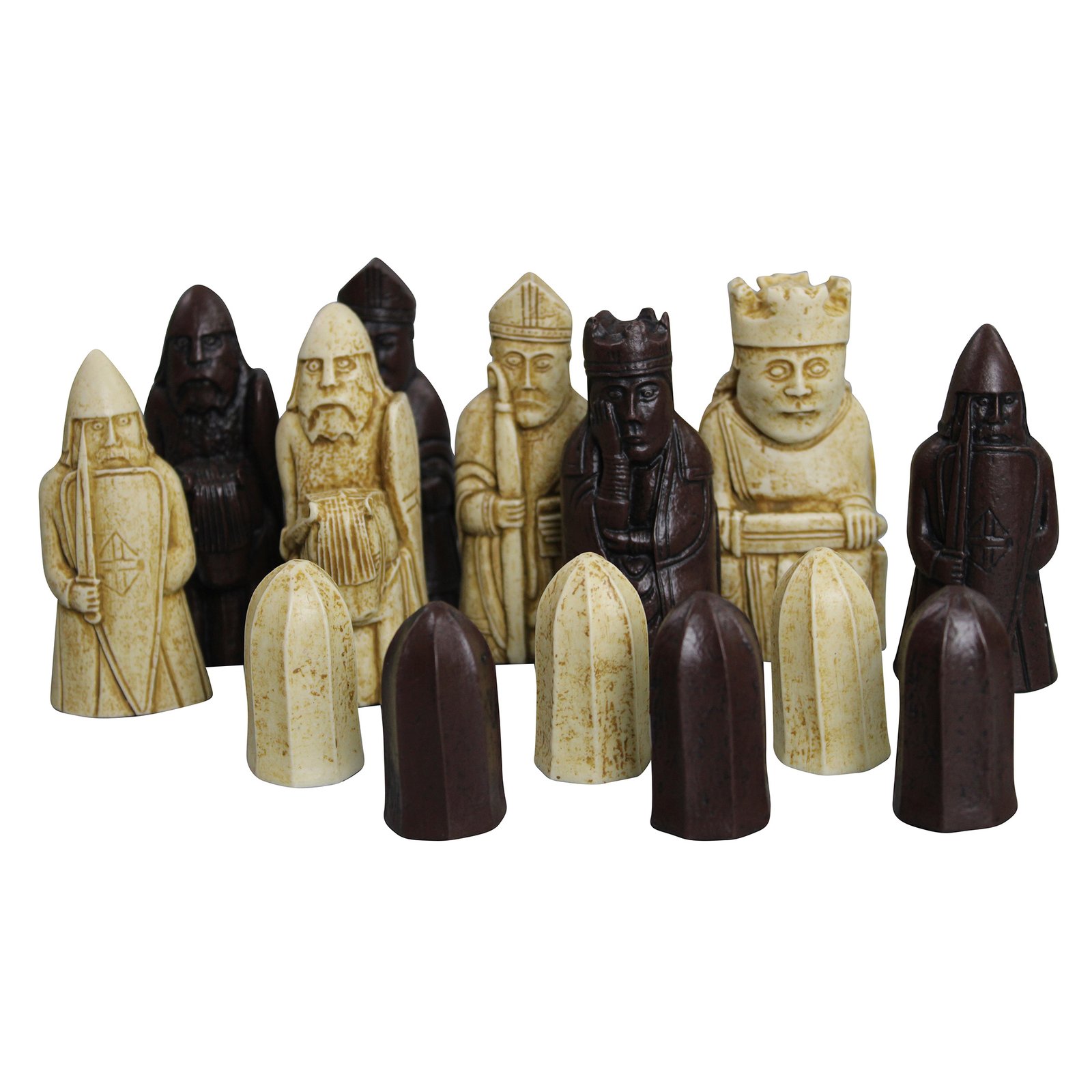Isle of Lewis Range Chess
Isle of Lewis Chess Set
The game of chess, with its intricate strategies and centuries-old tradition, has left an indelible mark on human civilization. Among the numerous chess sets that have graced the annals of history, one stands out as a true enigma, shrouded in mystery and steeped in Norse allure – the Isle of Lewis chess set. This captivating collection of chess pieces has become an iconic representation of history, art, and craftsmanship, intriguing scholars and enthusiasts alike. In this article, we embark on a journey through time to explore the captivating world of the Isle of Lewis chess set and uncover the secrets that lie within its ancient origins.
What is an Isle of Lewis chess set?
The Isle of Lewis chess set, also referred to as the Lewis Chessmen, stands as one of the most captivating and historically significant chess sets in the world. Crafted from walrus ivory and whales’ teeth, these remarkable chess pieces have fascinated art enthusiasts, historians, and chess players alike for centuries.
The set comprises 78 exquisitely designed pieces, each meticulously hand-carved to perfection. Within this diverse assembly, one can find kings and queens, representing the central figures of the game, as well as bishops, knights, warders (rooks), and pawns, each playing a crucial role in the chessboard’s strategic dance.
What sets the Lewis Chessmen apart and elevates them to the realm of true masterpieces is the breath-taking Viking artistry infused into their design. The chess pieces are adorned with intricate motifs and details, showcasing a melding of Norse, Celtic, and European influences. The expressive features of the characters evoke a sense of life and personality, a testament to the skill and dedication of the craftsmen who breathed life into these miniature works of art.
As with any ancient artefact, the Lewis Chessmen bear the marks of their time, providing valuable insights into the cultural exchanges and interactions prevalent during the Viking Age. It is believed that these exceptional chess pieces were created in Scandinavia, likely in Norway, during the 12th century. Their intricate design and artistic beauty serve as a lasting testament to the art and craftsmanship of this fascinating historical period.
The Lewis Chessmen have been celebrated and revered across the globe for their artistic excellence and historical importance. Today, the majority of the chess set is housed in the British Museum, drawing countless visitors to marvel at their brilliance and immerse themselves in the rich tapestry of human history.
As one gazes upon the Lewis Chessmen, they are transported back in time, tracing the steps of the ancient craftsmen who breathed life into these timeless pieces. The allure of the Isle of Lewis chess set lies not only in its inherent beauty but also in the tantalizing mysteries that surround its creation and discovery. As we continue to unravel the secrets of this ancient chess set, the Lewis Chessmen will undoubtedly remain an eternal symbol of the cultural and artistic heritage of the Viking Age.
How old is the Isle of Lewis chess set?
Indeed, the origins of the Isle of Lewis chess set are steeped in history and intrigue. These iconic chess pieces can trace their roots back to the 12th century, making them a staggering 900 years old. Crafted during the medieval period, they offer a mesmerizing window into the past, when Vikings ruled the seas and the art of chess was taking root.
Scholars and historians widely believe that the Lewis Chessmen were created in Scandinavia, with Norway being the most likely location. The evidence for this hypothesis lies in the distinctive Viking artistry and cultural influences that permeate the intricate carvings of the chess pieces. The Norse were renowned for their craftsmanship and artistic sensibilities, and these qualities are beautifully showcased in the Lewis Chessmen’s design.
Despite the consensus on their Scandinavian origins, the exact date and location of their creation continue to be the subject of scholarly debate. The lack of definitive historical records and the passage of centuries have contributed to the air of mystery that surrounds these enigmatic chess pieces. This mystery, however, has only added to their allure and allure.
The medieval period was a time of great upheaval and cultural exchange, with Vikings exploring new territories and trading with various cultures. It is through these interactions that the art of chess likely made its way to the Isle of Lewis in Scotland, where the chess pieces were ultimately discovered centuries later.
As we continue to unravel the enigma of the Isle of Lewis chess set, we are reminded of the inexhaustible allure of history and the enduring impact of human craftsmanship. These beautifully carved chess pieces stand as silent witnesses to the past, telling tales of a bygone era and inspiring generations to come with their exquisite artistry and timeless appeal.
Where is the original Isle of Lewis chess set?
The story of the Isle of Lewis chess set’s rediscovery is a tale of chance and serendipity that unfolded in the early 19th century on the Isle of Lewis in the Outer Hebrides, Scotland. In 1831, an ordinary local farmer was going about his daily activities when he stumbled upon a hidden treasure that would change the course of history for chess enthusiasts and archaeologists worldwide.
While the exact details of the discovery remain the subject of some debate, it is widely believed that the farmer accidentally unearthed the Lewis Chessmen from a sandbank at Uig Bay. The location of this chance discovery added an extra layer of mystery and allure to the already enigmatic chess set. These ancient chess pieces, once buried and forgotten, were suddenly brought back into the light after lying dormant for centuries.
The momentous find sparked a wave of excitement among locals and those who recognized the significance of the carved ivory and whales’ teeth chess pieces. Their intricate craftsmanship and Viking-inspired artistry immediately captured the imagination of scholars and art enthusiasts alike. It soon became evident that the Lewis Chessmen were no ordinary chess set – they were a priceless archaeological treasure with profound historical and cultural importance.
The chess pieces were quickly recognized as valuable relics that offered a unique glimpse into the world of chess and its ancient roots. Moreover, they shed light on the fascinating connections between the medieval period, Viking culture, and the strategic game of chess.
The discovery of the Lewis Chessmen marked a turning point in the fields of archaeology and chess history. As news of the find spread, interest in ancient board games surged, leading to new discoveries and research in the realm of ancient games and cultural exchanges.
Today, the majority of the Lewis Chessmen reside in the British Museum, where they continue to captivate and inspire visitors from around the world. The chess set’s accidental discovery on the Isle of Lewis has left an indelible mark on our understanding of the ancient pastime and its enduring relevance, ensuring that these extraordinary chess pieces remain an invaluable part of our shared human heritage.
How much are the Lewis Chessmen worth?
The Lewis Chessmen stand as a testament to the priceless value of cultural heritage and historical significance. As a representation of the artistry and craftsmanship of the Viking Age, their true worth extends far beyond any monetary measure. However, if one were to consider their potential monetary value, it would be substantial and reflective of their exceptional rarity and importance.
In 1993, a single piece from the Lewis Chessmen collection was the subject of a private offer of £5 million. This staggering sum speaks to the immense value that collectors and enthusiasts place on these ancient chess pieces. The rejected offer underscores the British Museum’s commitment to preserving and safeguarding these invaluable artifacts for the public and future generations to cherish and learn from.
Today, the collective value of the Lewis Chessmen would be beyond estimation. Their cultural and historical significance, coupled with their status as a rare and coveted archaeological find, would undoubtedly command an astronomical sum if they were ever to be sold on the open market. However, it is essential to remember that their true worth lies not in their potential monetary value but in the wealth of knowledge, insight, and inspiration they offer to scholars, art lovers, and chess enthusiasts worldwide.
The Lewis Chessmen’s place as one of the most treasured archaeological finds in the world is a testament to the enduring fascination with our shared human history and the remarkable artefacts that bridge the gap between the past and the present. As these exquisite chess pieces continue to inspire awe and wonder, their value as an irreplaceable cultural heritage remains immeasurable. Preserved in esteemed institutions like the British Museum, the Lewis Chessmen will continue to enrich our understanding of the past and serve as a beacon of the beauty and mysteries that lie within our shared human heritage.
What is the rarest chess set in the world?
The rarity of the Lewis Chessmen lies not only in their age but also in their remarkable state of preservation. Surviving the ravages of time, these ancient chess pieces have endured for nearly a millennium, providing an unparalleled link to the distant past. Their pristine condition allows us to marvel at the intricacies of Viking artistry, gaining insight into the cultural exchanges of the medieval period.
The quality of the Isle of Lewis chess set’s craftsmanship is nothing short of awe-inspiring. Each piece is a masterpiece of design and execution, reflecting the skills and artistic sensibilities of the ancient craftsmen who meticulously carved them. The expressive features, detailed clothing, and regal postures of the figures bring life to the chessboard, turning it into a stage for an epic battle of wits and strategy.
Yet, it is the historical importance of the Lewis Chessmen that truly sets them apart from other chess sets. They offer a unique glimpse into the world of medieval gaming, revealing how chess was not merely a pastime but a reflection of the cultural and social intricacies of the time. The mix of Viking, Celtic, and European influences in their design speaks to the interconnectedness of different civilizations during the medieval period.
While there are other valuable and historically significant chess sets scattered across museums and private collections worldwide, none have achieved the level of fascination and allure as the Isle of Lewis chess set. These ancient chess pieces have become an enduring symbol of the human desire for intellectual challenge and artistic expression.
The Lewis Chessmen continue to capture the collective imagination, serving as a tangible link to our past and a source of inspiration for the present and future. As they stand proudly displayed in the British Museum, these remarkable relics remind us of the richness of human history and the legacy we leave behind through art, culture, and the enduring allure of the game of chess.
How many Lewis Chessmen are missing?
The mystery surrounding the missing pieces of the Lewis Chessmen adds an extra layer of intrigue to these already enigmatic chess sets. Of the original 78 chess pieces, 67 of them found their way into the esteemed collection of the British Museum, where they are carefully preserved and admired by visitors from around the world. The remaining 11 pieces are housed in the National Museum of Scotland in Edinburgh, serving as a testament to Scotland’s historical connection to these exceptional relics.
The whereabouts of the missing pieces have been the subject of speculation and fascination for decades. While theories abound, the truth remains elusive. Some believe that the missing chessmen might still be hidden somewhere on the Isle of Lewis, waiting to be rediscovered by intrepid explorers or locals with a keen eye for history. It is not uncommon for archaeological treasures to lay hidden, buried beneath layers of time and soil, until the right moment leads them back into the light.
On the other hand, there are theories that suggest some of the missing pieces might have been lost over time, their journey obscured by the passage of centuries. Given the age of the chess set and the many historical events that have transpired since its creation, the loss of a few pieces is not entirely unexpected.
Despite the absence of the missing chessmen, the surviving pieces continue to captivate the imagination of chess enthusiasts and historians alike. The intricate craftsmanship and Viking-inspired artistry of the Lewis Chessmen provide valuable insights into the world of medieval gaming and the cultural exchanges of the time.
While the missing pieces leave an air of mystery, they also serve as a reminder of the fragility and impermanence of historical artifacts. As we continue to explore the Isle of Lewis chess set’s mysteries, we are reminded of the significance of preserving our cultural heritage and safeguarding the artifacts that connect us to our past.
The Lewis Chessmen, whether complete or partially missing, remain an eternal symbol of human ingenuity, creativity, and the enduring appeal of chess as a game of intellectual challenge and strategic mastery. As they continue to inspire generations, they will forever hold a cherished place in the hearts of chess enthusiasts and history aficionados, bridging the gap between the ancient past and the present.
Are the Lewis Chessmen Vikings?
Absolutely, the Lewis Chessmen provide strong evidence of their Viking connections and serve as invaluable relics of the Viking Age. The Viking Age, which spanned from the late 8th to the mid-11th century, saw Norse people from regions like Norway, Sweden, and Denmark embarking on extensive maritime expeditions, exploring and establishing settlements across Europe, Asia, and beyond.
The Isle of Lewis, where the chess pieces were discovered, was part of the Norse Kingdom of the Isles during this period. The presence of the Lewis Chessmen on the island further strengthens the connection to Viking culture and history. This historical context helps us understand how the chess set might have made its way to the remote island, reflecting the far-reaching influence of the Norse people during their age of exploration.
The art style of the Lewis Chessmen bears the distinctive hallmarks of Norse craftsmanship. The intricately carved details, expressive features, and representations of clothing and weaponry are all characteristic of Viking artistry. These elements evoke the tales of Norse sagas, heroic battles, and legendary figures, reflecting the cultural milieu of the time.
The clothing worn by the chess pieces, including the kings and warriors, resembles the traditional garments of the Viking Age, offering insights into the attire and fashion of that era. Additionally, the weaponry depicted, such as swords and shields, aligns with the military equipment used by the Norse warriors during their expeditions and conquests.
The chess set’s close association with Viking culture and its presence on the Isle of Lewis provide a tangible link to the historical interactions between different civilizations and the cross-cultural exchange that shaped the medieval period. The Lewis Chessmen stand as a testament to the vibrant tapestry of human history and the enduring legacy of the Viking Age.
As we marvel at the intricate beauty of the Lewis Chessmen and unravel their historical context, we gain a deeper appreciation for the rich heritage left behind by the Vikings and the remarkable impact of their maritime endeavours on the world’s cultural landscape. These timeless chess pieces continue to captivate our imagination, inviting us to explore the past and cherish the enduring allure of this ancient game.
Was the Lewis Chessmen found in England?
The Isle of Lewis Chessmen were discovered on the Isle of Lewis, which is part of the Outer Hebrides, located in Scotland, not England. The Outer Hebrides are a group of islands off the northwest coast of Scotland, known for their rugged beauty and rich cultural history.
The distinction between the Isle of Lewis and mainland Scotland is essential when discussing the origin and significance of the Lewis Chessmen. The presence of these remarkable chess pieces on the Isle of Lewis has long puzzled historians and archaeologists, as it remains uncertain why and how they ended up there.
Various theories have been put forth to explain their presence on the island. Some suggest that the chess pieces were part of a merchant’s cargo or a nobleman’s possessions that were lost or abandoned during a journey or a shipwreck. Others speculate that they might have been buried as part of a ritual or left as an offering to the gods.
Given the historical context of the Viking Age and the Norse Kingdom of the Isles, it is plausible that the Lewis Chessmen found their way to the Isle of Lewis through trade, conquest, or cultural interactions between the Norse and the inhabitants of the island.
Despite the uncertainty surrounding their origin, the discovery of the Lewis Chessmen on the Isle of Lewis in the early 19th century opened a window into the distant past, providing a remarkable insight into the cultural and historical connections of the medieval period.
As these enigmatic chess pieces continue to hold onto their secrets, they serve as a poignant reminder of the mysteries that lie within our shared human history and the enduring allure of the ancient game of chess. The Isle of Lewis Chessmen remains a symbol of cultural heritage and a testament to the value of preserving and cherishing the artefacts that connect us to our past.
Conclusion: The Isle of Lewis chess set stands as a timeless testament to the ancient game of chess and the rich cultural heritage of the Viking Age. As one of the most valuable and historically significant archaeological finds in the world, these beautifully crafted chess pieces continue to captivate the imaginations of people from all walks of life. Their story is a compelling journey through time, leaving us with an enduring sense of wonder and appreciation for the intricate interplay of history, art, and human ingenuity.
